When: Sunday 5 November 10:00 AM - 6:00 PM
Where: Eiteljorg Museum of American Indians and Western Art, 500 West Washington Street Indianapolis, IN 46204
Every other year the Eiteljorg Museum awards six Eiteljorg Fellowships for Native American Art to a distinguished artist for lifetime achievements and to five contemporary fine artists. A Very competitive, very prestigious, and worth some $20,000. Those selected in 2005 include:
Harry Fonseca (Maidu/Nisenan Portuguese, Hawaiian) expresses through his paintings the time and space in which we live, often whimsically reflecting the myths and ways of painting found throughout the world.
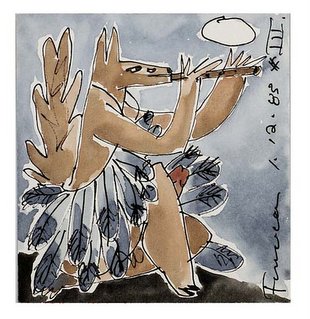

Harry Fonseca, Illumination (2001)
Extensive travels to Germany, Spain, the South Pacific, Mexico, Central and South America and Japan have allowed Fonseca to explore other cultural connections.
Tanis Maria S'eiltin (Tlingit) seeks to honor those who work in the best interest of her cultural heritage. 
Tanis S'eiltin Spawning a Red millennium
As a mixed media artist, her art reflects the ability of indigenous people to retain their cultural heritage despite corporate and U.S. government standards of identification. She believes that indigenous people are rich in culture and possess the ability to survive, to adapt and still maintain their identity.
C. Maxx Stevens (Seminole / Muscogee Nations of the Oklahoma Region) creates installations that carry on the storytelling tradition in a visual language. Each installation is based on her journey in life, her experience as a native person, her motivation and beliefs, and her family. For instance, her installation Four Directional House (2003)
is a reflection of her experiences growing up in a large, Seminole family in Wichita, Kansas. Like many Native people she was confronted with the conflicting interests of Christianity and indigenous interpretations of the world. The cross-shape of her suspended dwelling refers to Native understandings of the four directions, but could also refer to Christianity. The experience of living in a small home with up to ten family members is evoked through the thin walls of the structure. Much like the shadow of an airplane moving across the landscape of her childhood, the cross-shaped shadow on the Astroturf is impermanent.
James Lavadour (Walla Walla) worked for his Tribal Government for nearly 15 years in education, alcohol and drug treatment and land use planning.
James Lavadour, Overland (2003)
In 1990, he founded an organization called Crow's Shadow Institute for the Arts providing social, economic and education opportunities to Native Americans through artistic development. A self-taught artist, I find his paintings very familiar because they are so clearly drawn from the hills of Eastern Oregon where my family (like Lavadour's) are rooted.
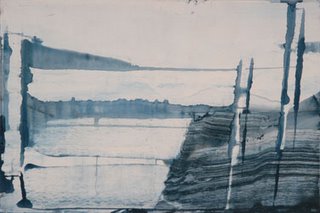
James Lavadour, Down River (2005)
Marie Watt (Seneca) works mainly in lithographs and sculpture. Born to the son of Wyoming ranchers and a daughter of the Turtle Clan of the Seneca Iroquois /Haudenosaunee) Watt identifies herself as "half Cowboy and half Indian." Formally, her work draws from Indigenous design principles, oral tradition, personal experience, and Western art history. Her approach to art-making is shaped by the proto-feminism of Iroquois matrilineal custom, political work by Native artists in the 60s, a discourse on multiculturalism, as well as Abstract Expressionism and Pop Art. 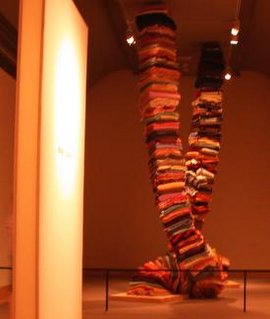
Marie Watt, Blanket Stories
Like Jasper Johns, she interested in "things that the mind already knows." Unlike the Pop artists, she uses a vocabulary of natural materials (stone, cornhusks, wool, cedar) and forms (blankets, pillows, bridges) that are universal to human experience (though not uniquely American) and noncommercial in character.
2006 Distinguished Artist: John Hoover (Aleut) is known for his intricate carvings which draw from myth, both cultural and personal. Seaweed People was installed in 1998 in the First LadyÂ’s Sculpture Garden at the White House. 
John Hoover, Seaweed People
Of Aleut-Russian and Dutch heritage, Hoover says he grew up rough; from the age of seven he had to fight for money, and when he was old enough, he fished, dug clams, and did odd jobs to support himself. For a long time he attempted to paint, withosuccessh succes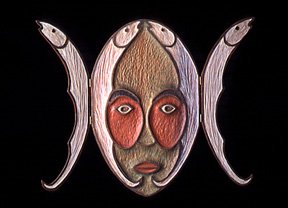 s, but when he was 41 he discovered carving and began to focus on Aleut culture as well as the Tlingit, Salish, and Haida myths of the Northwest Coast. The resulting carved cedar panels are infused with the spirit of these cultures. Sad, bewildered, calm, or wise faces look out from involved animal figures in shallow carvings, triptychs, or hanging forms, infused with soft natural colors. The elongated, overlaid figures often involve the theme of a spirit helper restoring lost portions of one's soul. Hoover has
s, but when he was 41 he discovered carving and began to focus on Aleut culture as well as the Tlingit, Salish, and Haida myths of the Northwest Coast. The resulting carved cedar panels are infused with the spirit of these cultures. Sad, bewildered, calm, or wise faces look out from involved animal figures in shallow carvings, triptychs, or hanging forms, infused with soft natural colors. The elongated, overlaid figures often involve the theme of a spirit helper restoring lost portions of one's soul. Hoover has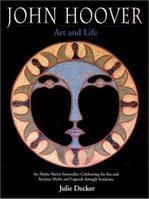 gone past the traditional Northwest Coast art to create his own style and technique. For a retrospective of Hoover's work at the Anchorage Museum of History and Art, curator Julie Decker wrote a fascinating biography, John Hoover: Art and Life. $60 is definitely worth the lavish reproductions of his art, and while you can get the book used, if you want simply to read Hoover biography you can read Decker's text here, here, here, here, here, and here. (Thanks to the good people at Google! for their caching feature that keeps pictures of pages even after they have been removed from the web.)
gone past the traditional Northwest Coast art to create his own style and technique. For a retrospective of Hoover's work at the Anchorage Museum of History and Art, curator Julie Decker wrote a fascinating biography, John Hoover: Art and Life. $60 is definitely worth the lavish reproductions of his art, and while you can get the book used, if you want simply to read Hoover biography you can read Decker's text here, here, here, here, here, and here. (Thanks to the good people at Google! for their caching feature that keeps pictures of pages even after they have been removed from the web.)
You ought to visit the Eiteljorg to view the works of these artists -- they are on exhibit from Nov. 5 to Jan. 29 2006. It will be yet another reminder of why Central Indiana is emerging as one of the country's most vibrant hubs of cultural and artistic life. To learn more about the issues that have shaped these and other Native Americ an artists you ought to attend the Eiteljorg Fellowship for Native American Fine Art Symposium, which will address issues in and around the exhibition of Native American fine art and its relationship with the mainstream. What is the role of the artist? Is it different for mainstream and indigenous artists? Where is the ethno-critical voice that represents Native American interests within the mainstream museums and galleries? The symposium will strengthen the appreciation for the substance of Native American fine art in the context of our popular culture.
an artists you ought to attend the Eiteljorg Fellowship for Native American Fine Art Symposium, which will address issues in and around the exhibition of Native American fine art and its relationship with the mainstream. What is the role of the artist? Is it different for mainstream and indigenous artists? Where is the ethno-critical voice that represents Native American interests within the mainstream museums and galleries? The symposium will strengthen the appreciation for the substance of Native American fine art in the context of our popular culture.
The symposium will incorporate two roundtable discussions, 3 panels, and a key note speaker. Each panel will consist of one moderator, and three panelists. Panel make-up will incorporate one representative from the mainstream community and two representing Native American interests.
10:00 - 11:30am Roundtable discussion. Among the questions that will be raised and will be probed throughout the day:
- What is the role of the artist?
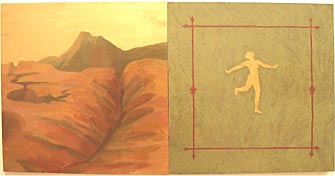
- Is that role different for indigenous and mainstream artists?
- Who defines what fine art is?
- Why do Native American and First Nation artists have difficulty competing in the mainstream?
- Do First Nations artists have a more or less difficult challenge than Native American artists?
- What are some of the issues Indigenous artists share with other cultures i.e. Asian, Latino challenges in the mainstream? What are the differences?
- What does a perfect contemporary art world look like? Why canÂ’t we get thereparticipantsp>Particiapnts will include:
Amei Wallach, President emeritus of the International Association of Art Critics/USA
Jessie Ryker-Crawford (White Earth Anishinabe/Chippewa) anthropologist
Kay WalkingStick, Cherokee artist
Margaret Archuleta (Tewa/Hispanic), co-author of Shared Visions: Native American Painters and Sculptors in the Twentieth Century
Patterson Sims, Director, Montclair Art Museum
11:45 - 12:45pm Lunch and Keynote speech
Joy Harjo (Mvskoke/Creek Nation) internationally known poet, performer, writer and musician. She has published seven books of acclaimed poetry. She co-edited an anthology of contemporary Native womenÂ’s writing: Reinventing the Enemiy's image: Native WomenÂ’s Writing of North America. Musically, she has been recognized by Pulse Magazine and by the First Americans in the Arts for Outstanding Musical Achievement. She has performed worldwide from Norway to India. Harjo is the Joseph Russo endowed professor at the University of New Mexico. This should be a treat, especially if Harjo performs any of her music. The politically cutting, often bitter lyrics of her music runs counter to her soft jazzy melodies and gentle voice.
Listen to Morning Song
Listen to Fear Song
1:00-2:00 PM Perception and Reality: Who's defining whom? Among the questions that are likely to be raised: 
- How are misperceptions created in the dominant culture and reinforced by the mainstream art world?
- What are subtle ways Native Americans are marginalized and kept out of mainstream art?
- What roles and responsibilities do institutions, like the Eiteljorg Museum and similar institutions, have in exposing indigenous artists to the mainstream art world?
- And finally, is the mainstream experience simply overrated?
Moderator: Lowery Stokes Sims, director of the Studio Museum in Harlem
Margaret Archuleta
Paul Chaat Smith, one of the country's leading voices on voices on issues of American Indian art, identity, mass culture and politics and co-author of Like a Hurricane: The Indian Movement from Alcatraz to Wounded Knee
Patterson Sims
2:15-3:15 PM Representation and Identity: Who owns the image of Nativ e Americans? Some of the questions to be discussed:
e Americans? Some of the questions to be discussed:
- How are indigenous artists changing the representation of Native People in film and photography?
- How similar or different is this representation to that of other indigenous cultures historically or in the contemporary mainstream?
Moderator: Brenda Child (Chippewa) professor of history at the University of Minnesota
Leanne Mella, U.S. Department of State Bureau of Educational and Cultural Affairs
Hulleah Tsinhnahjinnie (Dine/Seminole/Muskogee) photographer and artist
Shelley Niro (Mohawk), photographer
3:30-4:45 PM Individualism, Community, and the Dominant Society: What can indigenous artists teach the mainstream? The cult of individualism fuels the creative expression of most contemporary artists. How does the role of community in indigenous art create a more universal experience that many contemporary artists are able to achieve?
Jessie Ryker-Crawford (White Earth Anishinabe/Chippewa)
Kay WalkingStick
5:00-6:00pm Roundtable Discussion: Enduring and Change: What's next? In conclusion, there will be a roundtable discussion with the five Eiteljorg Fellows. In this case there will be a moderator who will address panel issues as they relate to the artists' individual experiences and art work.
Now that's a symposium!
For more information, check out ... the press package put out by the Eiteljorg. Note in particular the essay by the Eiteljorg's curator of contemporary art Jennifer Complo McNutt.
If you like this event, you should check out ... the Spirit & Place discussion of arts gravitating toward Indianapolis on Nov 17.

No comments:
Post a Comment